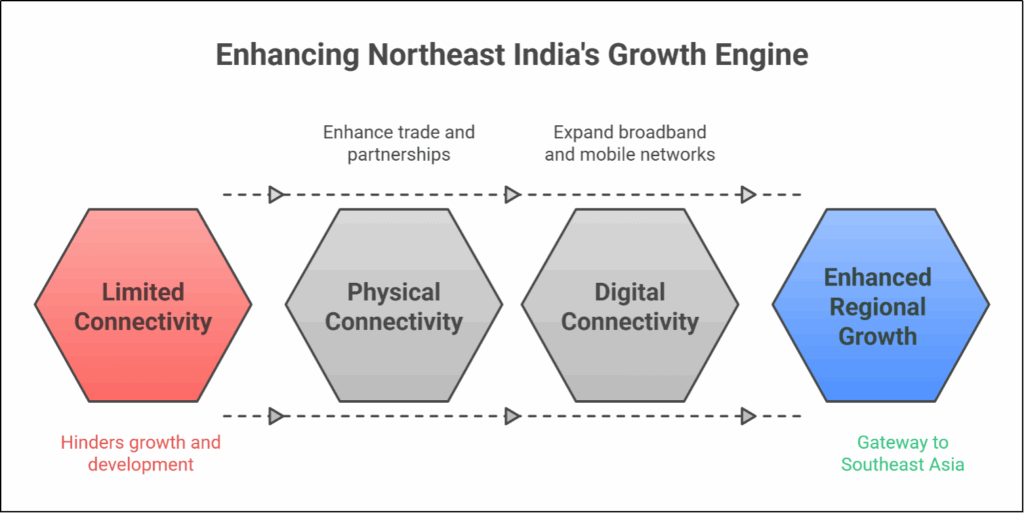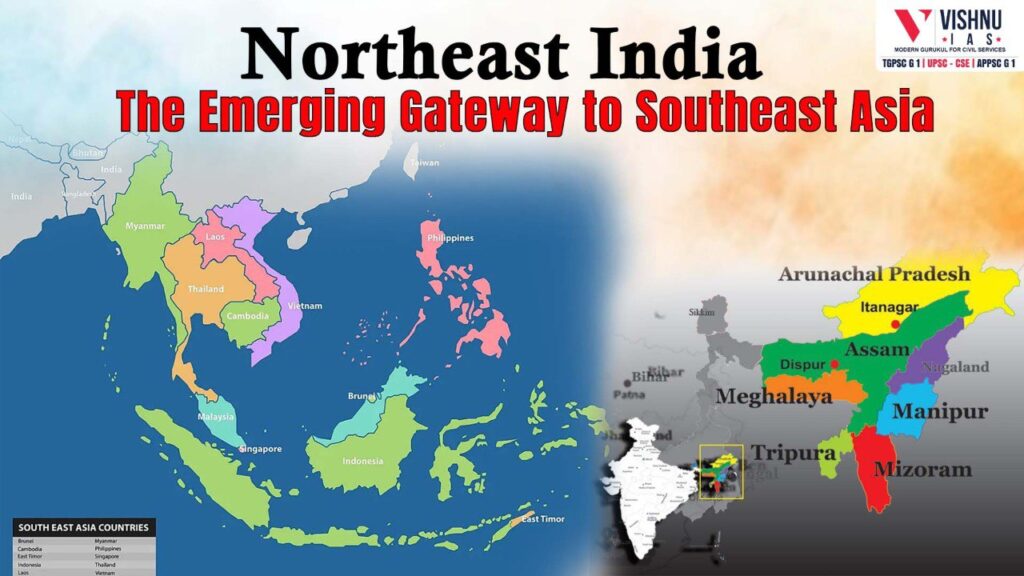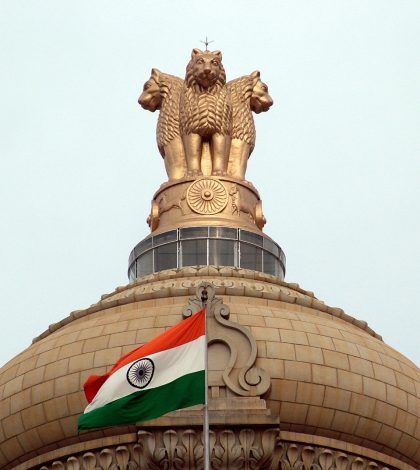Introduction
The Northeast region of India, once viewed as a frontier area, is now being recognized as a vital growth engine for the nation. Its strategic importance under India’s Act East Policy and its potential to connect India with Southeast Asia make it a crucial region for economic, cultural, and geopolitical developments. The recently concluded Rising Northeast Summit brought attention to the opportunities and challenges that lie ahead for the region.
A Vision of Connectivity and Growth

Strategic Location:
- The Northeast, sharing borders with Myanmar, Bangladesh, Bhutan, Nepal, and China, is uniquely positioned to be India’s gateway to ASEAN countries. Its location offers a significant advantage for trade, cultural exchange, and strategic partnerships.
Key Infrastructure Projects:
Several infrastructure projects highlight the government’s commitment to the region:
- The India-Myanmar-Thailand Trilateral Highway and the Kaladan Multi-Modal Transport Project aim to enhance connectivity.
- Revival of the Stilwell Road is expected to reinvigorate historical trade routes.
- Port connectivity, particularly through Sittwe Port in Myanmar, will boost trade efficiency.
Digital Connectivity:
- In addition to physical infrastructure, improving digital connectivity is vital. Expanding broadband access and mobile networks will bridge the digital divide and support e-commerce, education, and governance.
Harnessing Regional Diversity
Cultural Wealth:
- The Northeast is India’s most diverse region, with over 220 ethnic groups and 200 languages. This cultural richness is celebrated in events like the Hornbill Festival in Nagaland and the Bihu Festival in Assam.
Economic Potential:
The region’s unique resources and industries can drive economic growth:
- Tea production: Assam is a global leader in tea exports.
- Natural resources:Arunachal Pradesh has vast hydropower potential, while Meghalaya is rich in limestone and coal.
- Bio-economy:Bamboo, herbal medicine, and organic farming are burgeoning sectors.
Eco-Tourism and Sustainability:
- The pristine landscapes of the Northeast, including Kaziranga National Park and Loktak Lake, offer immense potential for eco-tourism. Promoting sustainable tourism can create jobs while preserving the region’s biodiversity.
Challenges to Overcome
Historical Issues:
- The Northeast has faced a history of insurgency, socio-political unrest, and marginalization. While peace agreements, such as the Assam Accord of 1985, have mitigated some tensions, ethnic conflicts and demands for autonomy persist.
Infrastructure Deficits:
- The region still struggles with inadequate transport networks, limited access to markets, and underdeveloped digital infrastructure. This lack of connectivity hampers trade and mobility.
Cross-Border Concerns:
- Porous borders with Bangladesh and Myanmar lead to challenges such as illegal trade, infiltration, and trafficking. Strengthening border management while facilitating legal trade is a key priority.
Environmental Concerns:
- The Northeast’s rich ecosystems are under threat from deforestation, climate change, and unregulated mining. Balancing economic development with ecological preservation is crucial for sustainable growth.
Government Initiatives and Policies
Act East Policy:
- Central to India’s Northeast strategy, this policy aims to deepen economic and cultural ties with Southeast Asia. It positions the region as a bridge between India and ASEAN.
Dedicated Ministries and Schemes:
- The Ministry of Development of the North Eastern Region (DoNER) oversees targeted investments and development programs. Initiatives like the North East Special Infrastructure Development Scheme (NESIDS) and NERLP aim to build infrastructure and create employment.
Skill Development and Entrepreneurship:
- Programs to upskill youth in agriculture, tourism, and technology sectors are empowering the workforce. Support for startups and SMEs encourages entrepreneurship.
Focus on Sustainability:
- The government emphasizes environmentally friendly policies, such as promoting organic farming and conservation-based tourism.
The Role of Tourism
Natural Attractions:
- The Northeast is home to diverse natural wonders, including Kaziranga National Park, known for the one-horned rhinoceros, and Loktak Lake, famous for its floating phumdis.
Cultural and Spiritual Tourism:
- Sites like the Kamakhya Temple in Assam and events like the Ziro Music Festival in Arunachal Pradesh attract both domestic and international visitors.
Challenges and Opportunities:
- While tourism has significant potential, it faces challenges such as inadequate infrastructure, limited international connectivity, and low global visibility. Investments in airports, hospitality, and marketing can make the region a global tourist destination.
A New Frontier of Economic Growth
Untapped Potential:
- Despite its vast resources, the Northeast contributes only 2.8% to India’s GDP. Addressing this disparity requires strategic investments and policy interventions.
Sectoral Focus:
- Hydropower:The region has an estimated potential of 60 GW.
- Agriculture and Allied Industries:Promoting organic farming and agro-processing.
- Industrial Development:Incentivizing industries like bamboo, silk weaving, and handicrafts.
Promoting Entrepreneurship:
- Supporting startups, providing better credit access, and creating incubation centers can drive localized growth and innovation.
Strategic Implications
Geopolitical Importance:
- The Northeast plays a vital role in counterbalancing China’s influence in Southeast Asia. Regional collaborations like BIMSTEC and the India-Myanmar-Thailand Trilateral Cooperation enhance its strategic value.
Domestic Integration:
- Integrating the Northeast into the national economy and reducing regional disparities will foster unity and inclusive growth. Historical grievances must be addressed through equitable development policies.
Conclusion
The Northeast is no longer a peripheral region but a central pillar of India’s growth and regional integration. Its transformation into a gateway to Southeast Asia reflects India’s strategic vision for economic and cultural connectivity.
While challenges persist, the region’s potential is vast. With targeted investments, robust infrastructure, and inclusive policies, the Northeast can become a global hub for trade, tourism, and innovation. This transformation will not only uplift the region but also strengthen India’s position in the Indo-Pacific region.
The Rising Northeast Summit marks a significant step in this journey. Collaborative efforts between the government, private sector, and local communities will ensure that the Northeast realizes its aspirations and contributes meaningfully to India’s growth story.


